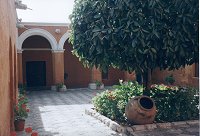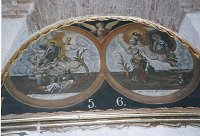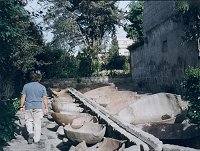Page
9
Next
stop, Arequipa. Flying in to the
airport we saw the unmistakeable conical lines of Misti Volcano and a sprawling,
spread out city. We arrived at
Hotel Maison d’Elise with its pretty, Mediterranean style rooms, Cable TV and
lovely en-suite bathroom quite early in the afternoon, so wandered out into the
city. Narrow, cobbled streets,
white buildings and the huge Plaza des Armas bustling with noise; cars hooting
and policemen blowing whistles while the Cathedral and colonnaded buildings
stand stately and elegant. The
building stone is white, volcanic sandstone and some of the Church facades and
graceful colonial buildings are quite magnificent in their ornate carving. The
city is spoiled for pedestrians by the local male habit of using Church walls,
convent walls, Bridge walls – indeed any walls – for relieving themselves.
With 360 days of sunshine the concentrated urine smell is quite
overpowering in side roads and on corners.
Most unpleasant, almost worse than a French pissoir!
There
are two notable places to mention in Arequipa, the Ice Maiden Museum and the
Santa Catalina Convent.
 The
story of the Inca Maiden is well presented in the Museo Santuarios de Altura. Situated in one of the lovely old, colonial houses is the
bizarre treble glass (or Perspex?) case containing the eerily grinning, frozen,
mummy – “Juanita” or the ‘Ampato Maiden’.
Every 5 hours she is re-frozen to maintain her condition and we had to
peer at her before the glass covered with ice crystals.
She was apparently buried in a pit on the top of the Ampato Mountain some
500-600 years ago, wearing fine Inca clothing, gold pins and surrounded by
various semi-precious artefacts as a sacrifice to the God of the Mountain.
A pure, unblemished child, drugged on coca leaves, semi-frozen after the
cold trek to the top of the mountain and then bashed on the head with a hammer.
“Juanita” was found in 1995 after a volcanic eruption on a
neighbouring volcano caused ash to melt some of the snow on Ampato and reveal
the mummy. At the end of the
visit we sat through a National Geographic film about the find; the studies, the
theories and the findings. It also
had a reconstruction of the ritual sacrifice – what a lonely and terrible
journey to one’s death.
The
story of the Inca Maiden is well presented in the Museo Santuarios de Altura. Situated in one of the lovely old, colonial houses is the
bizarre treble glass (or Perspex?) case containing the eerily grinning, frozen,
mummy – “Juanita” or the ‘Ampato Maiden’.
Every 5 hours she is re-frozen to maintain her condition and we had to
peer at her before the glass covered with ice crystals.
She was apparently buried in a pit on the top of the Ampato Mountain some
500-600 years ago, wearing fine Inca clothing, gold pins and surrounded by
various semi-precious artefacts as a sacrifice to the God of the Mountain.
A pure, unblemished child, drugged on coca leaves, semi-frozen after the
cold trek to the top of the mountain and then bashed on the head with a hammer.
“Juanita” was found in 1995 after a volcanic eruption on a
neighbouring volcano caused ash to melt some of the snow on Ampato and reveal
the mummy. At the end of the
visit we sat through a National Geographic film about the find; the studies, the
theories and the findings. It also
had a reconstruction of the ritual sacrifice – what a lonely and terrible
journey to one’s death.
Not
quite so bad was the self-inflicted seclusion of the nuns of Santa Catalina
Convent.  For four centuries the
nuns there took vows of poverty, celibacy and devotion.
Meeting with the public was not allowed, and even gifts brought to the
nuns were put in a dumb waiter cupboard that revolved so the recipients
couldn’t see the donors.
For four centuries the
nuns there took vows of poverty, celibacy and devotion.
Meeting with the public was not allowed, and even gifts brought to the
nuns were put in a dumb waiter cupboard that revolved so the recipients
couldn’t see the donors.
The
Convent itself was a miniature town with courtyards, cobbled streets, cloisters
and Church plus living quarters and kitchens. The Novices Cloister, painted white and terracotta, had 56 pictorial
depictions of the stations of the rosary round the upper walls – lest we
forget? Another courtyard with
religious paintings, painted a beautiful blue and white with red geraniums and
an orange tree in the middle. We
kept turning the left (the simplest way not to get lost!) and wandered at our
own pace through small rooms with bleak wooden platforms for beds; kitchens open
to the sky with kleftico ovens and blackened pots; a small, gloomy little chapel
of rest where nuns were laid on a wooden bier, surrounded by paintings of
previously deceased nuns, prior to being buried and two echoing, vaulted
dormitories. The small narrow
streets were photogenic in the sunshine, the garden a place of solitude and
peace and the laundry quite fascinating with about 18 large,
The Novices Cloister, painted white and terracotta, had 56 pictorial
depictions of the stations of the rosary round the upper walls – lest we
forget? Another courtyard with
religious paintings, painted a beautiful blue and white with red geraniums and
an orange tree in the middle. We
kept turning the left (the simplest way not to get lost!) and wandered at our
own pace through small rooms with bleak wooden platforms for beds; kitchens open
to the sky with kleftico ovens and blackened pots; a small, gloomy little chapel
of rest where nuns were laid on a wooden bier, surrounded by paintings of
previously deceased nuns, prior to being buried and two echoing, vaulted
dormitories. The small narrow
streets were photogenic in the sunshine, the garden a place of solitude and
peace and the laundry quite fascinating with about 18 large,  earthenware bowls
each with cold water pipe and plug. (I’d
rather have been a cooking nun than a washing nun!)
The main Church was somewhat gaudy – fairy lights and 2 fairy angels
surmounting the altar and case upon case of seriously gloomy models of Christ.
Favourite was Christ with blood – bloody head and thorns, bloody spots
on hands, body and feet, gashes of red on torso etc.
Second favourite – Mary in extravagant dresses and pained expression.
earthenware bowls
each with cold water pipe and plug. (I’d
rather have been a cooking nun than a washing nun!)
The main Church was somewhat gaudy – fairy lights and 2 fairy angels
surmounting the altar and case upon case of seriously gloomy models of Christ.
Favourite was Christ with blood – bloody head and thorns, bloody spots
on hands, body and feet, gashes of red on torso etc.
Second favourite – Mary in extravagant dresses and pained expression.
A
fascinating look into a life now totally disappeared – solitude, silence,
privation (squat loos etc.) praying and eating.
Home
Page 1 Page 2
Page
3 Page 4
Page
5 Page 6
Page
7 Page 8
Page 10 Page 11
 The
story of the Inca Maiden is well presented in the Museo Santuarios de Altura. Situated in one of the lovely old, colonial houses is the
bizarre treble glass (or Perspex?) case containing the eerily grinning, frozen,
mummy – “Juanita” or the ‘Ampato Maiden’.
Every 5 hours she is re-frozen to maintain her condition and we had to
peer at her before the glass covered with ice crystals.
She was apparently buried in a pit on the top of the Ampato Mountain some
500-600 years ago, wearing fine Inca clothing, gold pins and surrounded by
various semi-precious artefacts as a sacrifice to the God of the Mountain.
A pure, unblemished child, drugged on coca leaves, semi-frozen after the
cold trek to the top of the mountain and then bashed on the head with a hammer.
“Juanita” was found in 1995 after a volcanic eruption on a
neighbouring volcano caused ash to melt some of the snow on Ampato and reveal
the mummy. At the end of the
visit we sat through a National Geographic film about the find; the studies, the
theories and the findings. It also
had a reconstruction of the ritual sacrifice – what a lonely and terrible
journey to one’s death.
The
story of the Inca Maiden is well presented in the Museo Santuarios de Altura. Situated in one of the lovely old, colonial houses is the
bizarre treble glass (or Perspex?) case containing the eerily grinning, frozen,
mummy – “Juanita” or the ‘Ampato Maiden’.
Every 5 hours she is re-frozen to maintain her condition and we had to
peer at her before the glass covered with ice crystals.
She was apparently buried in a pit on the top of the Ampato Mountain some
500-600 years ago, wearing fine Inca clothing, gold pins and surrounded by
various semi-precious artefacts as a sacrifice to the God of the Mountain.
A pure, unblemished child, drugged on coca leaves, semi-frozen after the
cold trek to the top of the mountain and then bashed on the head with a hammer.
“Juanita” was found in 1995 after a volcanic eruption on a
neighbouring volcano caused ash to melt some of the snow on Ampato and reveal
the mummy. At the end of the
visit we sat through a National Geographic film about the find; the studies, the
theories and the findings. It also
had a reconstruction of the ritual sacrifice – what a lonely and terrible
journey to one’s death. 

